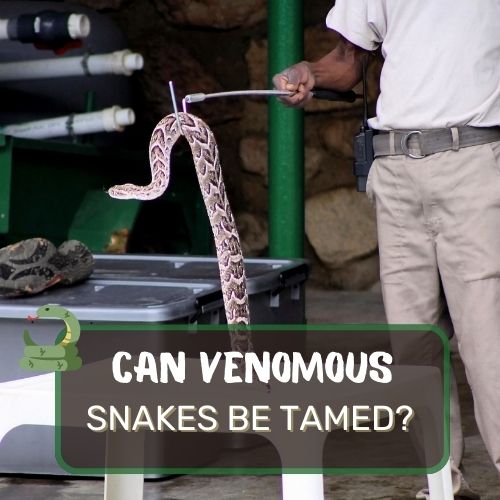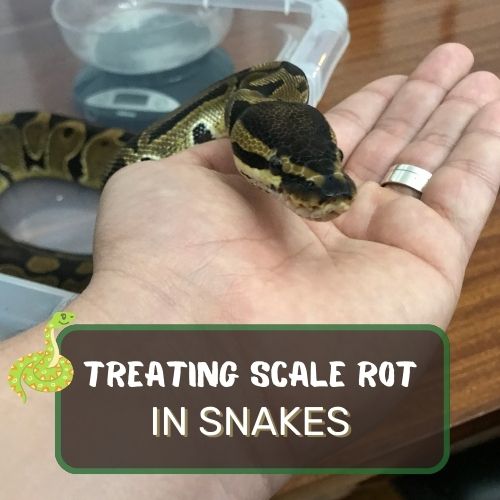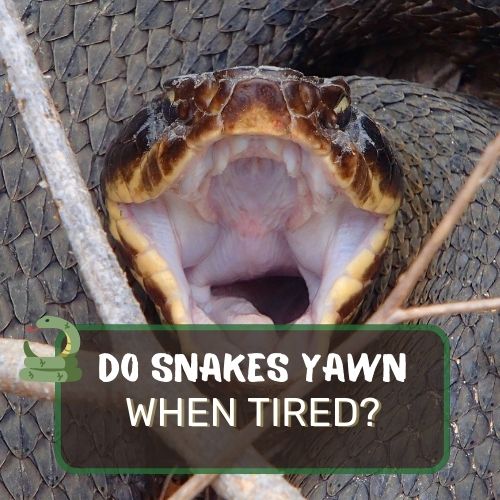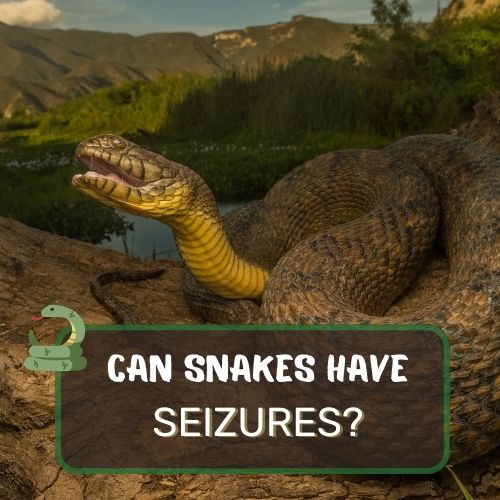
Delving into the intriguing question, “Can venomous snakes be tamed?,” this article explores the complexities and challenges associated with attempting to domesticate these enigmatic creatures.
By examining the unique biology, behavior, and inherent risks involved, readers will gain insights into the feasibility of taming venomous snakes.
We’ll navigate through the intricate interplay between human-animal interaction, exploring methods and case studies while discussing safety precautions and ethical considerations.
If you’re curious about the possibility of establishing a connection with these captivating creatures, this article offers a comprehensive analysis that highlights the factors influencing the taming potential of venomous snakes.
Table of Contents
Can venomous snakes be tamed? (Summary)
Taming venomous snakes presents significant challenges due to their unique biology, behavior, and inherent danger. While some instances of limited success might exist, the overall consensus within the scientific and herpetological communities leans toward discouraging attempts to tame these creatures. The complex instincts, lack of social behaviors, and potential risks associated with venomous bites make taming a perilous endeavor. Safety concerns for both handlers and the snakes themselves, along with ethical considerations, further emphasize the impracticality of taming venomous species.
Instead, enthusiasts seeking interaction and companionship are advised to explore non-venomous snake species that are better suited for domestication efforts.
Ultimately, the unpredictable nature and potential hazards of venomous snakes suggest that appreciating them from a distance is a wiser and safer approach.
Understanding Venomous Snakes

Definition of Venomous Snakes and Their Characteristics
Venomous snakes, characterized by their ability to inject venom into their prey, are fascinating yet potentially perilous creatures.
Unlike their non-venomous counterparts, venomous snakes possess specialized glands and fangs that enable them to deliver potent venom, often used for hunting or self-defense.
This venom contains a concoction of proteins and enzymes that can immobilize or even kill their prey.
Examples of Venomous Snakes
There’s a diverse array of venomous snakes found across the globe, each with unique characteristics.
Some well-known examples include the iconic King Cobra of Southeast Asia, the stealthy Black Mamba of Africa, and the rattlesnakes of North and South America.
These snakes vary in size, coloration, behavior, and potency of venom, making them a captivating subject of study for herpetologists and enthusiasts alike.
The Dangers and Risks Associated with Venomous Snakes
Interacting with venomous snakes poses inherent risks due to their potential to inflict harm through venomous bites. While many species of venomous snakes are elusive and prefer to avoid confrontations, encounters can sometimes occur in their natural habitats.
Understanding snake behavior and recognizing the warning signs they may exhibit can be crucial in avoiding unnecessary conflicts and dangerous situations.
Can Snakes Be Tamed? (Ultimate Guide)

The Concept of Taming and Domestication
Taming refers to the process of training wild animals to respond to human commands and exhibit behaviors that are conducive to human interaction.
Domestication takes this a step further, involving generations of selective breeding to create animals that are more amenable to living alongside humans. Historically, domestication has been applied to various species, including dogs, cats, and livestock.
The General Nature of Snakes and Their Suitability for Taming
Snakes, by nature, are solitary creatures with distinct behaviors that differ from those of domesticated animals.
Their lack of limbs and external ears, along with their reliance on vibrations and chemical cues, makes them fundamentally different from mammals and birds.
This inherent disconnect in communication and behavior poses significant challenges in taming them effectively.
The Difficulties and Challenges of Taming Venomous Snakes
Taming venomous snakes presents a set of obstacles that are even more complex than those faced with non-venomous species. The unpredictable nature of their behavior, the potential danger they pose, and their unique physiological traits make taming a daunting task.
While some experts claim limited success in taming certain venomous snakes, the risks associated with attempting such endeavors raise ethical concerns and questions about animal welfare.
The Opinions and Experiences of Experts and Snake Handlers
Veteran snake handlers and herpetologists possess a wealth of knowledge and experience in dealing with a variety of snake species.
While some might argue that select venomous snakes can be conditioned to tolerate human presence to some extent, the consensus remains cautious.
The consensus is that, due to the natural instincts and inherent danger of venomous snakes, it’s far safer and more responsible to appreciate them from a distance rather than attempt taming.
While there might be instances of successful interactions between humans and select venomous species, the inherent risks and complexities associated with these creatures strongly discourage such attempts.
As we continue to study and learn about the behaviors and characteristics of venomous snakes, it becomes clearer that these creatures are best admired and understood from a safe and respectful distance.
Examples Of People Taming Snakes
Where People Have Attempted to Tame Venomous Snakes
Despite the inherent challenges, there have been instances where individuals, often with a deep affinity for reptiles, have attempted to tame venomous snakes.
These cases range from hobbyists to trained professionals, each driven by a desire to unravel the mysteries of these captivating creatures.
The Outcomes and Challenges Faced in These Cases
While some limited success stories exist, the journey of taming venomous snakes is fraught with risks and difficulties.
The unpredictability of their reactions, the ever-present danger of venomous bites, and the inherent limitations of their behavior often result in less-than-ideal outcomes.
Even with dedicated efforts, the results are often far from the level of companionship and interaction achieved with domesticated animals.
Comparison of the Results with Taming Non-venomous Snakes
In contrast, the taming of non-venomous snakes appears to yield more favorable results.
Non-venomous species, which possess behaviors more aligned with social learning and environmental adaptation, are generally more responsive to taming efforts.
This highlights the inherent challenges posed by the biology of venomous snakes, making them a unique and complex subject within the realm of animal behavior and domestication studies.
The exploration of taming venomous snakes unveils the intricate interplay between biology and behavior.
While cases of successful taming might exist, the underlying challenges stemming from the biology and instincts of these creatures make it a perilous and demanding endeavor.
As we delve deeper into the biological complexities, we gain a greater appreciation for the untamed nature of these remarkable beings.
Training and Conditioning

The Methods and Techniques Used in Training Venomous Snakes
Training venomous snakes involves a delicate blend of patience, understanding, and persistence. Experts have experimented with classical conditioning, operant conditioning, and positive reinforcement methods.
These techniques aim to create associations between certain cues and positive experiences, gradually coaxing the snake into more predictable and manageable behaviors.
The Effectiveness and Limitations of These Training Methods
While some success stories exist, the effectiveness of these training methods is limited by the innate nature of venomous snakes. Their unique instincts and behaviors often override conditioned responses, making consistency a challenge.
Additionally, the variability in individual snake temperament and the potential for setbacks underline the complexity of taming these creatures.
The Importance of Consistent and Proper Handling Techniques
Consistency in handling is paramount when attempting to tame venomous snakes. Regular, gentle interactions can reduce stress and minimize potential aggressive behaviors.
By employing proper handling techniques, snake handlers can establish a level of familiarity that, while not true “taming,” allows for safer interactions and reduced likelihood of defensive responses.
Safety Precautions and Risks When Handling Snakes

The Safety Precautions Required When Handling Venomous Snakes
Safety precautions are of paramount importance when dealing with venomous snakes. Protective clothing, including specialized gloves and bite-resistant clothing, is essential to minimize the risk of potentially life-threatening bites.
Isolation and containment protocols ensure that both the handler and the snake remain safe during interactions, reducing the likelihood of accidents.
The Potential Risks and Dangers Associated with Taming Venomous Snakes
Taming venomous snakes carries inherent risks. Even with the most cautious approach, the unpredictability of their behavior and the possibility of reflexive bites remain constant concerns.
While some handlers have managed to establish a level of rapport with specific individuals, the broader risks of handling venomous snakes outweigh the potential benefits, often leading experts to advise against such endeavors.
The Legal and Ethical Considerations of Keeping Venomous Snakes
The legal and ethical dimensions of keeping venomous snakes further complicate the discussion.
Many regions require specialized permits for ownership, reflecting the potential dangers associated with these creatures.
Moreover, ethical questions arise concerning the well-being of the snake itself and the potential dangers it poses to both handlers and the broader community.
The challenges posed by the unique nature of these creatures, the risks associated with their handling, and the broader legal and ethical considerations ultimately converge to discourage attempts at taming.
While the allure of creating a connection with these enigmatic creatures is strong, the wisest approach is to admire their wild nature from a respectful distance, allowing them to fulfill their ecological roles undisturbed.
Alternative Options for Snake Enthusiasts

Non-venomous Snake Species That Can Be Tamed and Kept as Pets
For snake enthusiasts seeking interaction and companionship, non-venomous snake species offer a safer and more feasible option.
Popular pet snake species like the Corn Snake, Ball Python, and Garter Snake are more amenable to handling and taming.
These snakes possess behaviors that are better suited for domestication attempts and can provide snake enthusiasts with fulfilling experiences.
The Benefits and Challenges of Keeping Non-venomous Snakes
Keeping non-venomous snakes as pets presents a unique set of benefits and challenges. These snakes are generally more adaptable to captive environments, allowing for greater success in taming efforts.
They come in a variety of sizes, colors, and patterns, catering to a range of preferences. However, they still require proper care, habitat, and handling techniques to ensure their well-being and to avoid stress-related behaviors.
The Different Breeds and Characteristics of Non-venomous Snakes
Non-venomous snake breeds offer a diverse array of choices for prospective snake owners.
From the docile and easy-to-handle Ball Pythons to the active and colorful Corn Snakes, each species has its own unique characteristics and care requirements.
Researching the specific breed’s needs and behaviors is essential for providing a comfortable and enriching environment for these captivating reptiles.
FAQ
Can King Cobras Be Tamed?
Taming king cobras, one of the largest and deadliest venomous snakes, is exceedingly risky and discouraged. Their complex behaviors, potent venom, and natural instincts make them unsuitable candidates for taming efforts. While some handlers have worked with king cobras in controlled settings, the inherent danger remains, making such endeavors highly unsafe.
Can You Devenom a Venomous Snake?
While it’s theoretically possible to remove a snake’s venom glands, the procedure is complex, risky, and generally not recommended. Removing the venom glands can disrupt the snake’s biological functions, and the snake may still exhibit defensive behaviors. Additionally, this practice raises ethical concerns and poses significant animal welfare issues.
Can a Snake Hurt Itself with Its Own Venom?
Yes, snakes can inadvertently injure themselves with their own venom. While their immune systems are adapted to handle their own venom, direct exposure to the eyes or sensitive tissue can cause irritation and damage.
Snakes often use their venom for hunting or defense, and accidental self-envenomation can occur if they strike at a reflective surface or bite themselves during certain behaviors.
In your pursuit of understanding whether venomous snakes can be tamed, it’s important to consider the safety, ethics, and practicality of such endeavors.
While the allure of taming these captivating creatures is undeniable, the complexities of their biology, behavior, and potential risks emphasize the importance of responsible and informed decisions when it comes to interacting with these extraordinary animals.
Conclusion
In the world of venomous snakes and their potential for taming, we’ve journeyed through the intricate web of biology, behavior, and human-animal interaction.
The unique characteristics and instincts of venomous snakes, combined with the risks and challenges of taming, underscore the complexity of this topic.
While instances of taming might exist, the overall consensus points to the inherent danger and ethical considerations associated with attempting to domesticate these creatures.
For snake enthusiasts and curious minds, the allure of understanding and interacting with venomous snakes is undeniable. However, it’s crucial to approach this fascination with caution and respect for the natural behaviors and roles of these animals.
As an alternative, exploring the world of non-venomous snake species offers a safer avenue for interaction and companionship, while still allowing for the appreciation of these remarkable reptiles.
Ultimately, the question of whether venomous snakes can be tamed is a nuanced one, rooted in the complexities of biology, behavior, and human safety.
By acknowledging the limitations and risks associated with taming, we can embrace a perspective that values the conservation of these creatures in their natural habitats, allowing them to fulfill their ecological roles while we admire their beauty and intrigue from a safe distance.




0 Comments